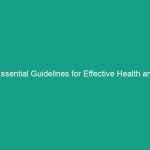Introduction
Good morning team! Today, we are going to discuss a critical aspect of our Workplace Safety: Essential Workplace Inspection Guidelines. This Toolbox Talk aims to enhance our understanding of workplace inspections and how they can help us avoid critical risks. Ensuring our Environment is safe not only protects us but also fosters a culture of Safety and productivity.
Why is this topic important? Because regular inspections help identify Hazards before they lead to accidents or injuries. By understanding and implementing these guidelines, we can create a safer workplace for everyone.
Understanding Essential Workplace Inspection Guidelines
So, what exactly are Essential Workplace Inspection Guidelines? In simple terms, these are systematic Procedures used to identify Safety Hazards in our work environment. They are designed to ensure compliance with safety Regulations and help minimize risks associated with various tasks.
The importance of these guidelines cannot be overstated. Regular inspections not only protect our physical health but also contribute to our mental well-being by fostering a secure work environment. Unfortunately, there are misconceptions that inspections are merely formalities or bureaucratic hurdles. In reality, they are vital tools for proactive risk management.
Key Hazards, Risks, and Safety Considerations
When we talk about workplace inspections, there are specific hazards and risks we must consider:
- Slips, Trips, and Falls: These are among the most common workplace accidents. Inspecting floors, walkways, and stairs can help identify potential hazards.
- Equipment Safety: Regular checks on machinery and tools are crucial. Malfunctioning equipment can lead to serious injuries.
- Chemical Hazards: Identifying and managing hazardous materials is essential in maintaining a safe work environment.
- Fire Hazards: Regular inspections can prevent potential fire risks by checking for faulty electrical wiring and ensuring fire exits are accessible.
Ignoring these risks can have real-world consequences, such as workplace injuries, financial loss, and even legal repercussions. It is imperative that we take these inspections seriously.
Best Practices, Procedures, & Actionable Advice
Now that we understand the importance of workplace inspections, let’s delve into some Best Practices and actionable steps we can take:
Step-by-Step Safety Procedures
- Plan the Inspection: Determine what areas or equipment need inspection. Make a checklist of potential hazards.
- Conduct the Inspection: Walk through the area systematically. Use your checklist to ensure nothing is overlooked.
- Document Findings: Record any hazards or safety concerns observed during the inspection. Be specific about the location and nature of each hazard.
- Implement Corrective Actions: Prioritize the hazards based on their severity and likelihood of occurrence. Address the most critical issues first.
- Follow Up: Schedule a follow-up inspection to ensure that corrective measures have been implemented effectively.
For instance, let’s consider a real-world incident where a lack of inspection led to a major injury. In a manufacturing plant, an uninspected machine malfunctioned, causing a worker to suffer a serious injury. This incident could have been prevented with regular inspections, highlighting the importance of adhering to our guidelines.
Regulations, Standards, and Compliance
Understanding regulations is essential for compliance and safety. In the United States, the Occupational Safety and Health Administration (OSHA) sets forth regulations that dictate Workplace Safety standards. These regulations require employers to provide a safe work environment, which includes conducting regular inspections.
Compliance with these Standards is not just about avoiding penalties; it protects employees and fosters a culture of safety. When we adhere to these guidelines, we contribute to a safer and more productive workplace.
Employee Engagement & Discussion
Engaging with you, the employees, is crucial for successful implementation of these guidelines. Let’s reflect on some questions:
- What safety challenges have you encountered related to workplace inspections?
- How can we improve our inspection processes to make them more effective?
- Do you feel empowered to report hazards, and what can we do to encourage that?
Discussion around these questions will help us identify gaps in our current processes and improve our safety culture together.
Conclusion & Key Takeaways
In summary, we have explored the Essential Workplace Inspection Guidelines and their critical role in maintaining a safe work environment. Remember the key points:
- Regular inspections help identify and mitigate risks.
- Documentation and corrective actions are essential for effective safety management.
- Compliance with regulations protects both the company and its employees.
Let’s prioritize safety and ensure that we are vigilant in our inspections. Together, we can cultivate a safer workplace for everyone. Thank you for your attention and commitment to our safety protocols. Let’s make today a safe day!


